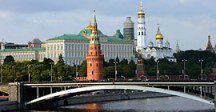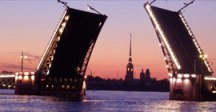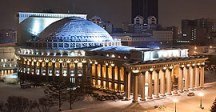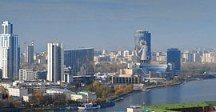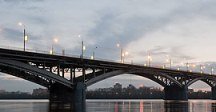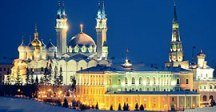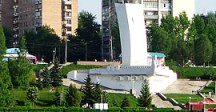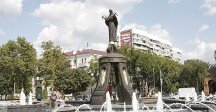Map of Moscow
Detailed interactive map of Moscow. Map of Moscow with streets and numbers of houses. Satellite map of Moscow with sights of the city.
The change between the satellite map of Moscow and the schematic one is made in the lower left corner of the interactive map.
Moscow
Moscow population: 12,655,050 (2021)
Moscow area: 2,561 km?.
Date of foundation of Moscow: 1147
Moscow phone code: +7 495, 496, 498, 499.
Moscow car codes: 77, 177, 777; 97, 197, 797; 99, 199, 799.
Moscow postal codes: 101000-135999.
The capital of Russia and one of the largest cities in the world is Moscow. More people live in Moscow than in Norway or Finland. 15 million people is an unofficial figure, and most of the residents are newcomers.
What to see in Moscow
There are many attractions in the Russian capital, some of which have been appreciated even by UNESCO. These are not only architectural monuments, but also temples of the capital. The most famous place in the city, which is always full of tourists, is the Red Square, where the Kremlin stands.
It is these monuments that are included in the World Heritage List. There is also an interesting place in the historical part of the city – Arbat. It is a place of concentration of musicians, street performers and artists, as well as cafes and souvenir shops.
The Red Square
No visit to Moscow will be complete without visiting two of its most famous attractions: St. Basil's Cathedral on Red Square and the neighboring Kremlin, both of which are UNESCO World Heritage Sites and are located in the heart of Moscow.
Lenin's Mausoleum, the State Historical Museum and the GUM department Store are also located on Red Square. You need to buy tickets to visit the territory inside the Kremlin, where you will see the Assumption and Annunciation Cathedrals, several churches and palaces, as well as the Tsar Bell and Tsar Cannon. There are two more popular museums in the Kremlin: the Armory, which is a real treasure trove of Russian history, and the Diamond Fund, where you can see collections of imperial crown jewels.
The Cathedral of Christ the Savior
The most important cathedral in Russia is the Moscow Cathedral of Christ the Savior. It is also the largest cathedral, with a capacity of 10,000 people. In 2007, the funeral of President Yeltsin took place in the cathedral, and in 2008, the funeral of Patriarch Alexy II.
Tretyakov gallery
Of the many museums in Moscow, one of the most popular among tourists is the State Tretyakov Gallery, which is one of the leading art galleries in the world, where some masterpieces of Russian art are presented. The gallery is named after its founder Pavel Tretyakov, who began collecting works of art in the middle of the 19th century, and later donated his collection to the city of Moscow.
Artists whose works are represented in the gallery include Nikolai Ge, Kazimir Malevich, Ilya Repin, Ivan Shishkin, Vasily Surikov, Viktor Vasnetsov, Vasily Vereshchagin and Mikhail Vrubel. There are also ancient icons, including works by masters Andrei Rublev and Dionysius, as well as the revered icon of the Vladimir Mother of God.
Gorky park
Moscow is one of the greenest metropolitan cities with many parks and even forests within its borders. The most famous of its parks is probably Gorky Park, which was created on the banks of the Moskva River in 1928 and named after the writer Maxim Gorky in 1932.
In 2011, the park received a new lease of life after a large-scale reconstruction. Many of its buildings have been restored, outdated rides have been removed and the park has been transformed into a modern, environmentally friendly recreation area with plenty of places for sports and outdoor activities. In winter, the park turns into the largest ice rink in Europe.
Novodevichy monastery
One of the most beautiful sights of Moscow is the Novodevichy Monastery, which was included in the UNESCO World Heritage List in 2004. The Novodevichy Monastery was founded as a fortified convent in 1524 by order of the Grand Duke of Moscow Vasily III to commemorate the return of Smolensk by Russia in 1514.
Today, the monastery is operated as a branch of the State Historical Museum, although some of its churches have been reopened for worship. Next to the monastery is the place where many of the most famous figures of Russian culture are buried, including Mikhail Bulgakov, Anton Chekhov, Sergei Eisenstein, Nikolai Gogol, Vladimir Mayakovsky, Yuri Nikulin, Mstislav Rostropovich, Konstantin Stanislavsky and many others.
Moscow State University
There are seven Gothic-style skyscrapers around the center of Moscow, which were built under Stalin and have since become known as Stalin's Skyscrapers. Perhaps the most impressive of them is the main building of Lomonosov Moscow State University, which stands at the top of the Vorobyovy Gory.
It is the tallest building of the seven skyscrapers, reaching 182 meters in height or 240 meters along with the spire. The MSU building was built between 1949 and 1953, and its chief architect was Lev Rudnev. Its facade is decorated with sculptures by the famous sculptor Vera Mukhina. In addition to the impressive building, there is an observation deck right in front of the entrance to the university, from which you can enjoy a magnificent view of the city.
Old Arbat
Arbat Pedestrian Street, which is usually called the Old Arbat to distinguish it from Novy Arbat Street, is one of the most famous streets in Moscow. The street has existed since at least the 15th century and became the first pedestrian zone in Moscow in the 1980s.
Since then, the Old Arbat has become a favorite place for both locals and tourists. In addition to bookstores and souvenir stalls, the Old Arbat is famous for the fact that street performers gather here. There are many bars, restaurants and fast food establishments on the street, as well as the Vakhtangov Theater.
Victory park
One of the main attractions in the west of Moscow is Victory Park, which was created in honor of the victory of the Soviet Union in World War II. Today it is an important place to celebrate Victory Day in Russia on May 9, where veterans gather, who are thanked and given flowers by the younger generations. The park is dominated by the massive Victory Monument, which stands in front of the semicircular Central Museum of the Great Patriotic War.
All-Russian Exhibition Center of VDNH
The All-Russian Exhibition Center in the north of Moscow was officially opened in 1939 as the All-Union Agricultural Exhibition, but after World War II it was reconstructed, and in 1959 it was reopened as an Exhibition of Achievements of the National Economy. Immediately behind the center there is an equally impressive monument to the Conquerors of space and the iconic monument "Worker and Collective Farmer".
Vernissage and Izmailovsky Kremlin
Not everyone knows that Moscow has a second Kremlin, located in the Izmailovo district. However, unlike the main Kremlin, the Izmailovsky Kremlin is not a historical place, but a modern wooden cultural and entertainment complex. Here you will find many replicas of medieval palaces, as well as restaurants, shops and even a registry office.
There are museums and exhibitions dedicated to bread, Russian toys, decorative and applied arts, as well as the wooden church of St. Nicholas. The Izmailovsky Vernissage was built on the territory of the Izmailovsky Kremlin, which is the largest market for applied arts in the world and is popular among tourists hunting for Russian souvenirs.
If you are looking for souvenirs, then this is the place for you, as Vernissage has the largest selection and the best prices, especially if you can bargain. Behind the souvenir market there is a flea market where you can buy all kinds of items, including many Soviet-era curiosities.
Kolomenskoye Manor
One of the most popular estates in Moscow and one of the most popular attractions outside the city center is the Kolomenskoye Estate. During the reign of Tsar Alexei Kolomenskoye became the royal residence, and a magnificent wooden palace was built here.
Several wooden buildings from different parts of Russia were also brought to the estate for preservation, including the hut of Peter the Great, who was born in the Kolomenskoye estate. The estate occupies a very large area, and the main area worth visiting in the estate is the Royal Court and Voznesenskaya Square.
Moscow Metro
The Moscow Metro is often credited with being the most beautiful metro system in the world. When it was designed, it was conceived not only as a means of getting from point A to point B, but also as a holiday for workers. Many stations are decorated with themed panels, mosaics, chandeliers, sculptures and stained glass windows of various artistic styles and look more like underground palaces than metro stations.
Thus, the Moscow metro itself is a tourist attraction, and it cannot be missed. The most beautiful metro stations are located on the ring line. In any case, the Moscow Metro is often the best way to get around the capital, as it is extremely efficient and avoids Moscow traffic jams.
The Moscow Kremlin
The Kremlin is a medieval Russian fortress, usually built in a strategically important location along the river and separated from the adjacent parts of the city by a wall with a moat, ramparts, towers and battlements. Many capitals of the principalities - Moscow, Pskov, Novgorod, Smolensk, Rostov, Suzdal, Yaroslavl, Vladimir and Nizhny Novgorod - were built around old kremlins, which usually housed cathedrals, palaces of princes and bishops, and government offices.
The Moscow Kremlin dates back to 1156. Originally built of wood, it was rebuilt in stone in the 14th century and then in red brick in the 15th century. The jagged brick walls of the Kremlin and 20 towers were built by Italian architects invited to Moscow by Ivan the Great at the end of the 15th century.
The Spasskaya Tower, leading to Red Square, was built in 1491 by Pietro Solario, who designed most of the main towers. The chimes, dating from 1851-1852, are broadcast on the radio as a time signal to the whole of Russia.
The only modern building in the Kremlin is the State Kremlin Palace (1960-1961). Originally called the Palace of Congresses, it now accommodates a huge hall with 6,000 seats and serves as a theater.
Red Square stretches along the eastern wall of the Kremlin. In the shadow of the Kremlin walls stands Lenin's Mausoleum, the burial place of the leader of the Russian revolution of 1917. At the southern end of Red Square is the Pokrovsky Cathedral, better known as St. Basil's Cathedral.
Along the Red Square opposite the Kremlin there is the GUM State Department Store, a huge shopping center located in a building built from 1889 to 1893. The State Historical Museum (1875-83) closes the northern part of the square.
List of the most famous sights of Moscow
Kremlin, Ostankino TV Tower, St. Basil's Cathedral, Tsar Bell, Lenin Mausoleum, Poklonnaya Gora, Gorky Park, Bolshoi Theater, GUM, the Main Building of Moscow State University, Stalin Skyscrapers, Triumphal Gates, Government House of the Russian Federation, Tsar Cannon, Faceted Chamber, Cathedral of Christ the Savior, Patriarchal Ponds, Kremlin in Izmailovo, Shukhov Tower, the State Tretyakov Gallery, Kuskovo, the Moscow Zoo, Novodevichy Monastery, Novodevichy Cemetery, Grave of the Unknown Soldier, Armory, Kazan Cathedral, Senate Palace, Monument to Minin and Pozharsky, Exhibition of Achievements of the National Economy (VDNH), Russian State Library, Pashkov House, Ivan the Great Bell Tower, Tchaikovsky Moscow State Conservatory, State Kremlin Palace, Annunciation Cathedral, Vakhtangov Theater, Maly Theater, Assumption Cathedral, Taganka Theater, Arkhangelsk Cathedral, etc.
The largest cities in Russia:
2024 © Russia-Karta.ru
